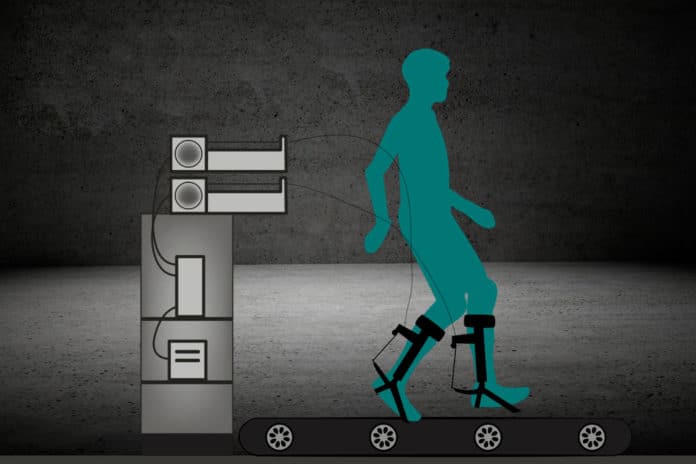Being unable to walk quickly can be frustrating and problematic, but it’s a common problem, especially as people get older. Exoskeletons may increase walking speed, but the mechanisms behind these changes and the upper limits on performance are unknown.
A team of engineers at Stanford University has developed a prototype ankle exoskeleton that can greatly help people walk faster while burning less energy. The exoskeleton attaches around the shin and into a running shoe, letting the wearer select a preferred walking speed. The system is powered externally by motors and controlled by an algorithm.
Currently, the ankle exoskeleton system is an experimental emulator that serves as a testbed for trying out different designs. As the wearer walks, the exoskeleton acts as a mechanical calf muscle, putting a bit of force into every step. The tether – that runs up the length of the back of the exoskeleton – tugs the wearer’s heel upward, helping them point their toe down as they push off the ground. This can increase the user’s walking speed by about 40% compared with their regular speed.
Engineers tested ten young participants’ walk in normal shoes without the exoskeleton, with the exoskeleton turned off and with the exoskeleton turned on with three different modes: optimized for speed, optimized for energy use, and a placebo mode adjusted to make them walk more slowly.
An algorithm repeatedly adjusted the exoskeleton settings while the user walked on the treadmill. Finding the speed-optimized mode of the operation took about 150 rounds of adjustment and two hours per person. With torque optimized for speed, participants walked 42% faster than in normal shoes. The speed-optimized mode also reduced energy use by about 2% per meter traveled.
Now engineers plan to focus future versions of the ankle exoskeleton emulator on reducing energy use consistently across users while also being more comfortable. They also plan to run future tests with older adults and to look at other ways the exoskeleton design can be improved. The team hopes that future designs could reduce pain caused by weight on joints or improve balance in older adults.
“A 40 percent increase in speed is more than the difference between younger adults and older adults,” said Steve Collins, associate professor of mechanical engineering at Stanford. “So, it’s possible that devices like this could not only restore but enhance self-selected walking speed for older individuals, and that’s something that we’re excited to test next.“
